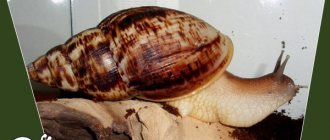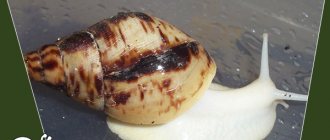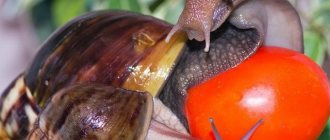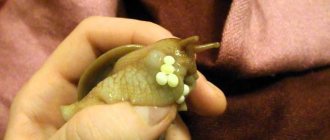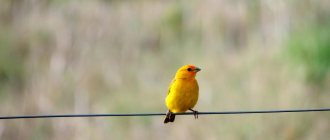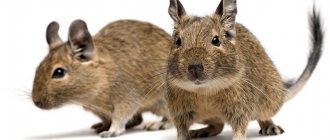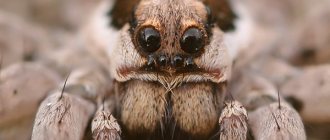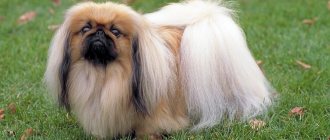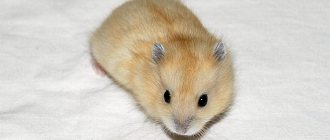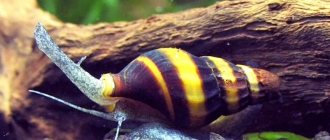Effect of terrarium volume
In order for the Achatina snail to grow huge and quickly, it is worth buying a spacious house for it. This could be a terrarium, an aquarium, or a large food container. The main condition is that the walls of the room must be transparent, and the utilitarian itself must be well ventilated. Its volume should exceed the size of the snail at least five times. Accordingly, the displacement should start from 20 liters or more. In cramped housing, the snail will slow down in development, or even stop growing altogether.
Read more about choosing the right house for a snail in our article
As for ventilation, it can be provided by 4-5 holes on one of the four sides of the house. You need to drill holes 5-6 cm below the roof. On the opposite side, the procedure is repeated, only this time 5-6 cm above the ground level. This will ensure constant air circulation. And the terrarium itself is closed with a lid. Otherwise, the pet will be able to crawl beyond its boundaries and begin an unauthorized journey around the apartment.
Proper diet of the Achatina snail
The basis of the Achatina diet is represented by lettuce leaves, various greens, shoots of cereal crops and vegetables, as well as tops. The diet of shellfish should also include the following products:
- cucumber and pumpkin pulp;
- spinach;
- zucchini;
- carrots;
- cobs of young corn;
- peas;
- tomatoes;
- cabbage;
- apple and pear pulp;
- watermelon and melon;
- bananas;
- apricots;
- avocado;
- mango;
- pineapples;
- cherries;
- plum;
- raspberries;
- strawberries
Adult gastropods can be a little capricious when it comes to nutrition, so they often give preference to certain foods while completely neglecting others. In any case, soft fruits and vegetables are cut into slices, and hard ones are grated or crushed in a kitchen blender until pureed. Any food given to the snail should be brought to room temperature.
It is forbidden to give your pet food from the common table, spices and fried foods, sweet and sour, as well as smoked and spicy foods . Natural acids contained in citrus fruits, including lemons, tangerines and oranges, are dangerous for snails. It is very important to provide the gastropod with a special mineral supplement containing a sufficient amount of calcium.
This is interesting! Clean water is especially important for the gastropod, which Achatina not only drinks, but also very actively uses for water procedures. Water must be replaced daily.
It is advisable to feed adult domestic snails in the evening, once a day. Small and young animals should be provided with round-the-clock and unhindered access to food and water. Food is given in a special bowl or on a tray, which may well be a cabbage or lettuce leaf. Uneaten food is removed from the terrarium.
Return to content
Habitat
This genus began its existence on the coast of East Africa, where the climate is characterized by high temperature and humidity. Now wild snails have moved to Central Africa, as well as to southern Asia. In Japan and Brazil you can still find farms where Achatina is mined. In Europe and America, giant snails are found as pets.
The type of terrain and relief does not matter for the mollusk. Giant snails can be found everywhere where there is a relatively warm climate and high humidity.
At temperatures above +10 °C, the snail becomes active and becomes an agricultural pest. If it is too cold, the animal hibernates.
Photo gallery of the Achatina snail:
Possible diseases
With proper maintenance and proper nutrition, snails should not get sick. There is no need to throw them or subject them to other mechanical stress. In the absence of external chemical, bacteriological and thermal irritants, Achatina will not be able to receive harm from the environment.
To be safe, a person just needs to wash his hands with soap after contact with the creature.
Main pathologies of snails:
- Mechanical - any sufficiently strong interaction.
- Chemical - contact with a caustic substance, namely citrus fruits, oxidation products, soap, etc.
- Thermal - a sharp directed impact of extremely high or low temperature.
- Bacterial – parasite activity. Organ prolapse may occur as a result of infection.
What do you need to remember?
Achatina giant is often attacked by various parasites, and diagnosis, as well as treatment, in this case is impossible. For this reason, you should only purchase a snail from a trusted pet store, where it was raised in sterile soil. Since only compliance with all hygiene standards can prevent infection.
Living in a terrarium and eating the food you offer it, the snail may become lethargic and inactive. And if the humidity and temperature are at the optimal level, then the problem may be hidden in the food. The fact is that vegetables often contain pesticides, the consumption of which can lead to the death of your pet. Sometimes the cause is the detergent you use to clean the terrarium. That is why it is recommended to wash the house with clean water without any impurities.
Large and beautiful mollusk shell
A healthy and beautiful snail shell is its pride.
It is created by special glands at the edge of the shell. Often the health of a mollusk is judged by its growth on the shell. If Achatina does not receive enough calcium, the growth is very fragile and easily breaks when touched. The condition of the shellfish is influenced by many factors, for example, dry and dirty substrate, rotting food debris, direct sunlight, contact with salt, chemicals and detergents. The snail's growth can stop its pregnancy, so keep the snail away from others. The sexual maturity of the mollusk is signaled by a white bulge on the neck.
Features of the view
The main characteristic feature of albinos Achatina is their white body.
This doesn't happen very often in nature. But there are people who breed exactly this type of mollusk. Therefore, if you want to raise small albinos in the future, you should purchase parents from reliable breeders or in a pet store. Animals are characterized by rapid growth. It continues for up to a year, after which it stops completely. At the age of one year, the pet is capable of producing offspring. Achatina albino has a beautiful shell. Unlike the body, the shell comes in different shades, from light to dark.
Snails prefer to bury themselves in the ground during the day and sleep. And when evening comes, they begin to actively tinker in their terrarium, eat, swim, and watch everything that happens in the owner’s apartment. That is why gastropods are fed in the evening. Until then, it’s better not to bother them at all.
Reproduction
The domestic Achatina snails are extremely prolific. In addition, they are hermaphrodites and can bear offspring regardless of the presence of a different-sex partner. If you do not want a new offspring, simply wash off the eggs (they look like chicken eggs, only in miniature) with water. But if you want to breed snail offspring, you should be more careful when cleaning the terrarium. It should be cleaned so as not to change the air humidity and not damage the masonry. To prevent newborn Achatina from suffocating in the loose soil of the litter, you need to keep them on lettuce or cabbage leaves.
Baby food should be treated with special responsibility. To make a strong shell grow faster, give the young animals calcium porridge. Grated carrots are very useful for him. Achatina becomes sexually mature at the age of nine months, but their reproductive instinct should be restrained until one and a half years. Just make the substrate layer in the terrarium less than three centimeters. One snail lays two to three hundred at a time, and the number of clutches can reach up to four per year. Do not release unwanted snails into the wild during the summer. Firstly, they will die during the first cold snap at night, and secondly, Achatina is an extremely invasive parasite. In Great Britain, a law has even been passed prohibiting the release of Achatina into the wild. What can we say about countries where many agricultural areas are covered with vineyards!
How to choose a house for Achatina
Remove food debris every day and wash the snail's drinking bowl and feeder every two days.
The African snail is a guest from warm and humid Africa, so at home it is kept in a plastic container, terrarium or rectangular aquarium. The house for her should be spacious and match the size of the animal.
A mollusk under the age of 6 months feels comfortable in a small container (about 30 cm); for an adult animal, the volume of the home is 15-20 liters. The house for Achatina should be equipped with a tightly closing lid, and holes should be drilled for ventilation. The terrarium should be equipped with a thermometer and hygrometer. The optimal temperature for keeping Achatina is 24-28 degrees. You can beautifully decorate a snail’s home with your own hands. Cleaning the terrarium with a complete replacement of the soil should be carried out at least once a week. Do not use detergents. By keeping the terrarium clean you will prevent the development of mold and various bacteria.
Mineral supplements
Calcium is an important component that Achatina extremely needs. Care and maintenance of snails involves regular feeding with edible chalk. In addition to this, you can provide them with the necessary “building material” for the shell in the form of pureed eggshells, sepia, shell rock, gammarus, cottage cheese (without salt and other food additives). Give your pets calcium cereal (a mixture of grains and minerals) occasionally. Do not forget that in the wild, Achatina does not disdain carrion. Therefore, occasionally you can give them meat puree, bone meal, boiled eggs, minced meat. If a snail doesn't get enough calcium, its shell becomes thinner. Consequently, its internal organs, which are attached to the inside of the shell, become vulnerable.
